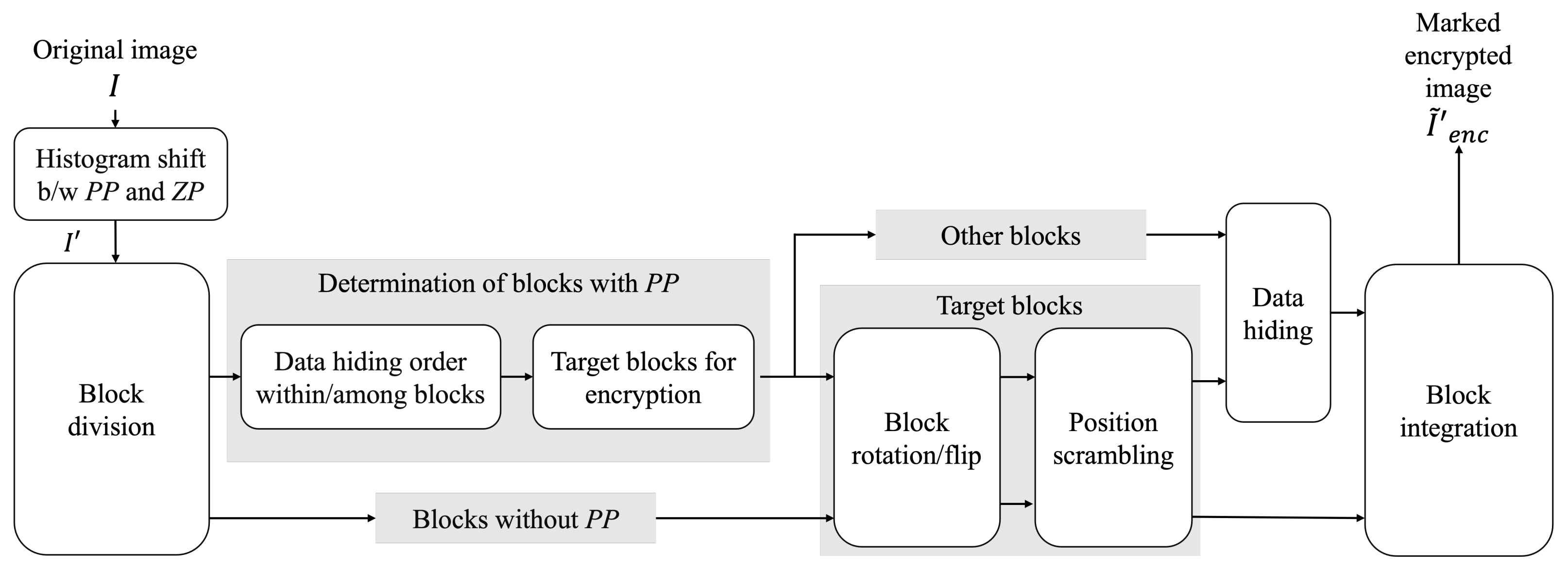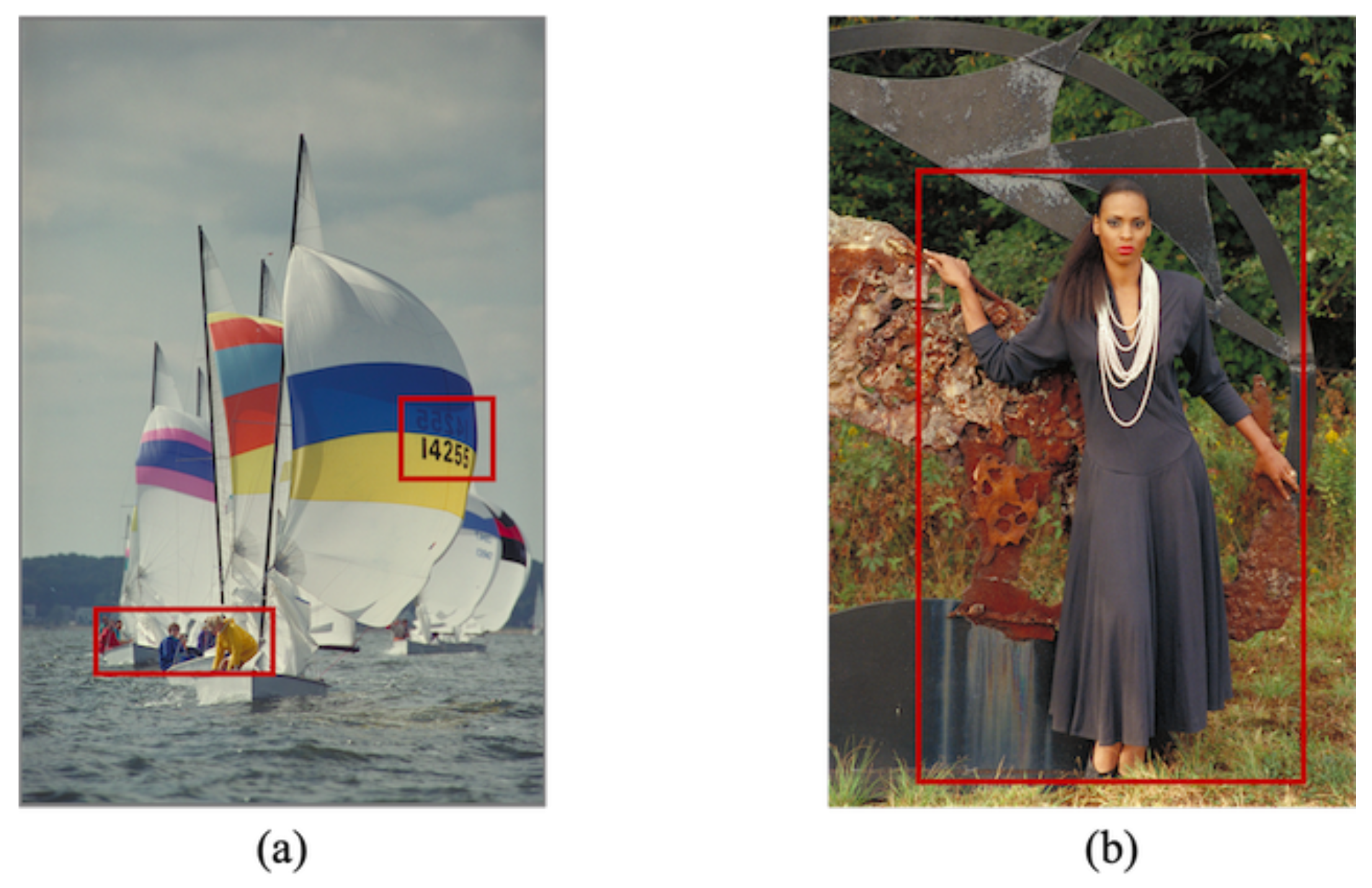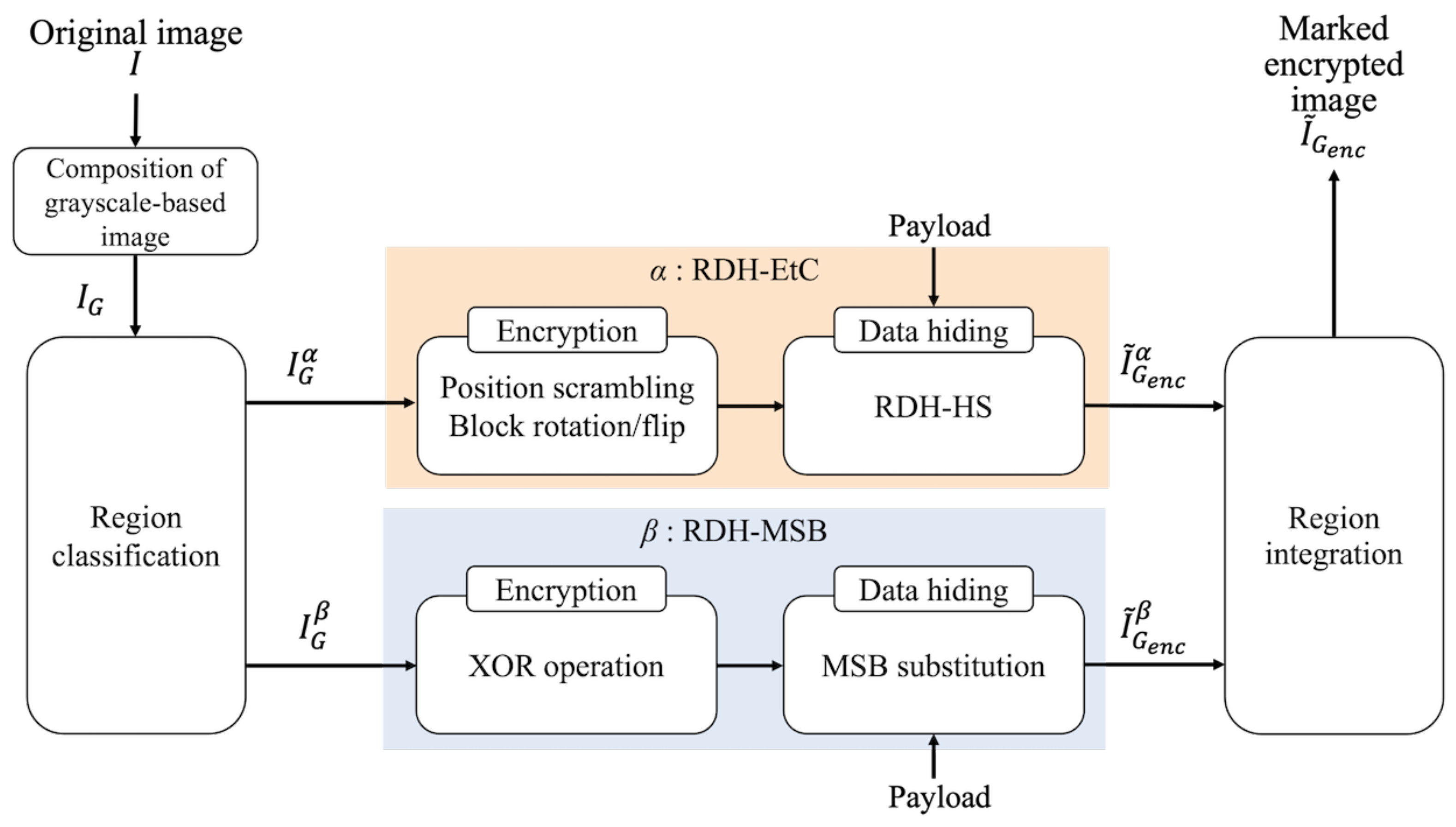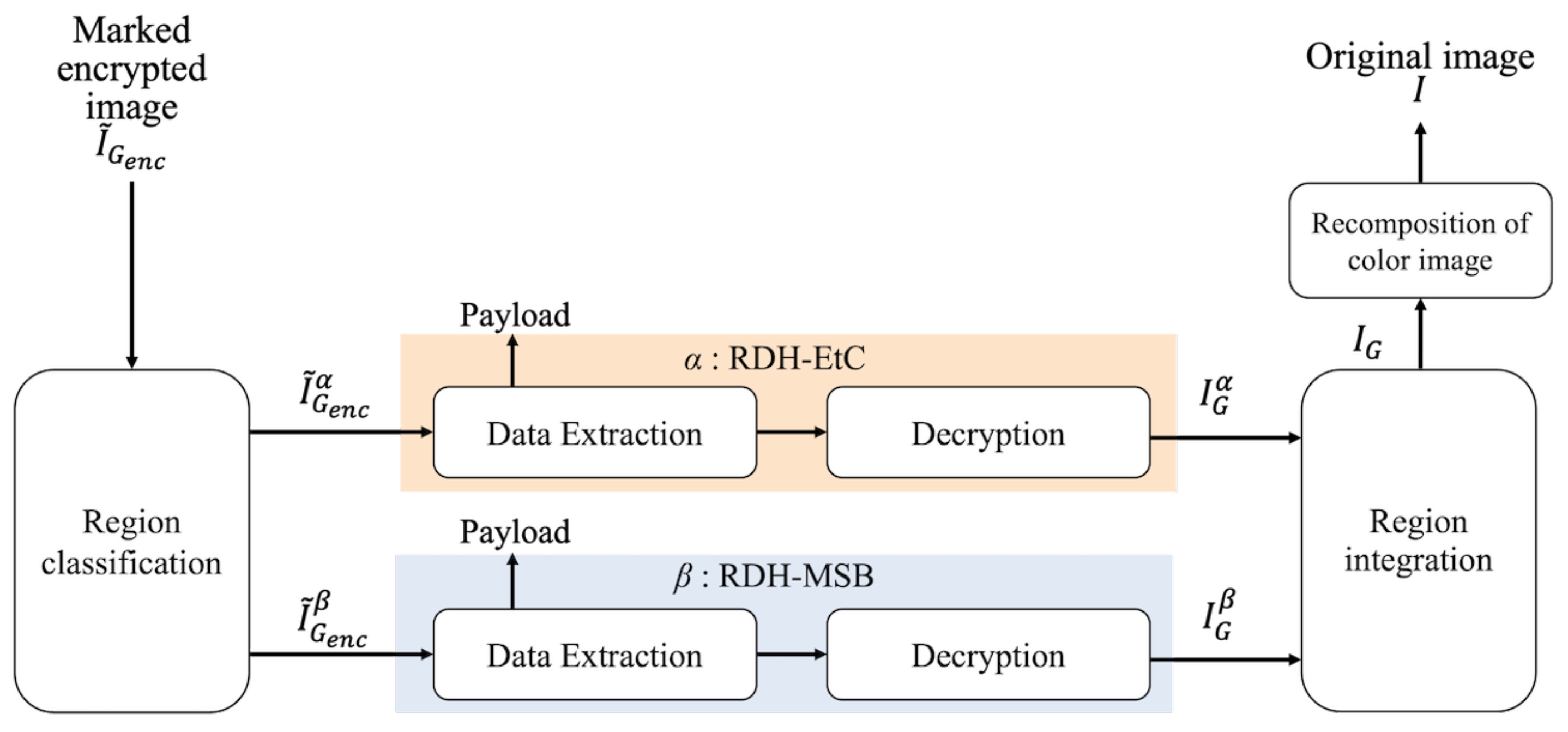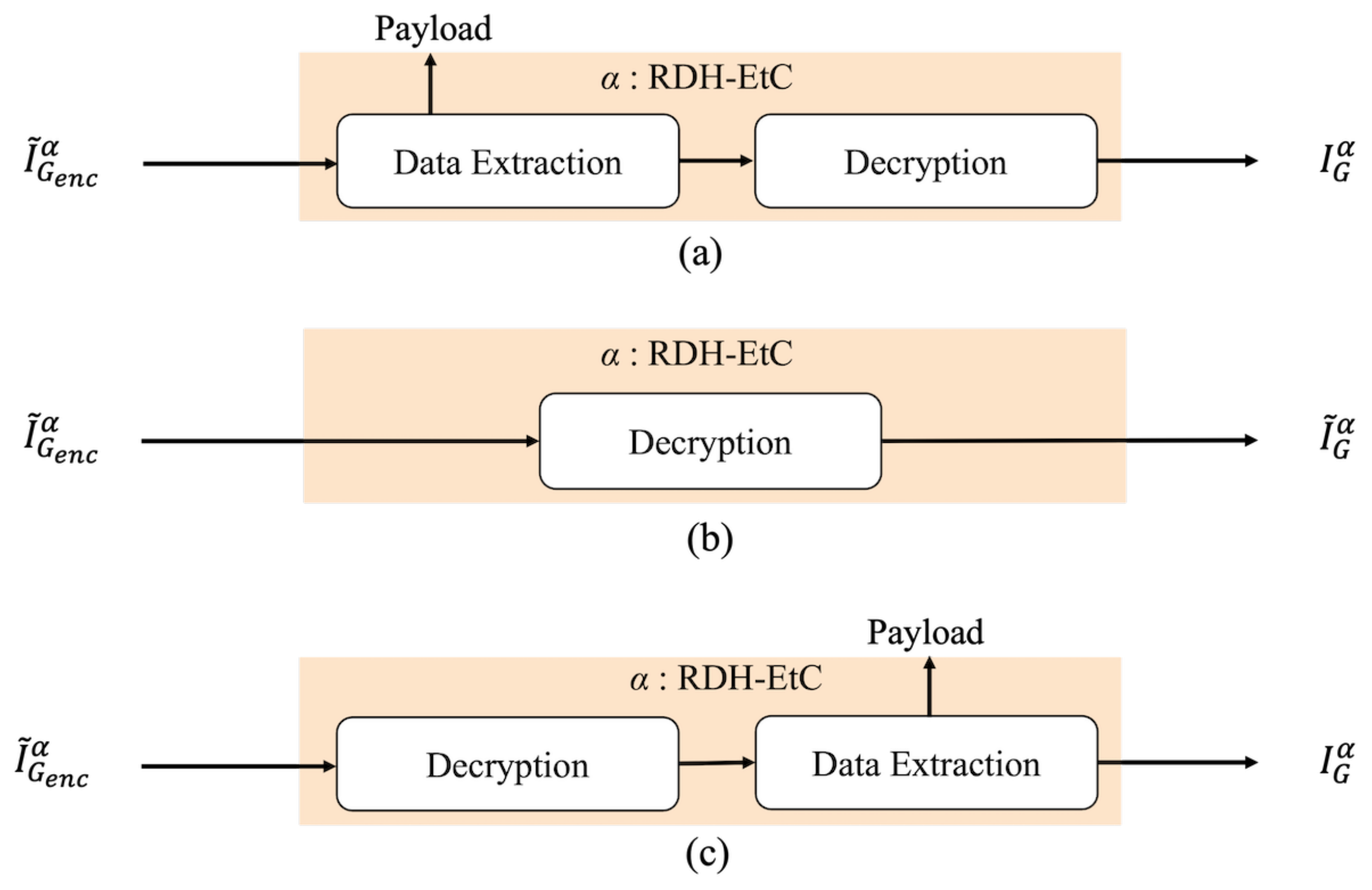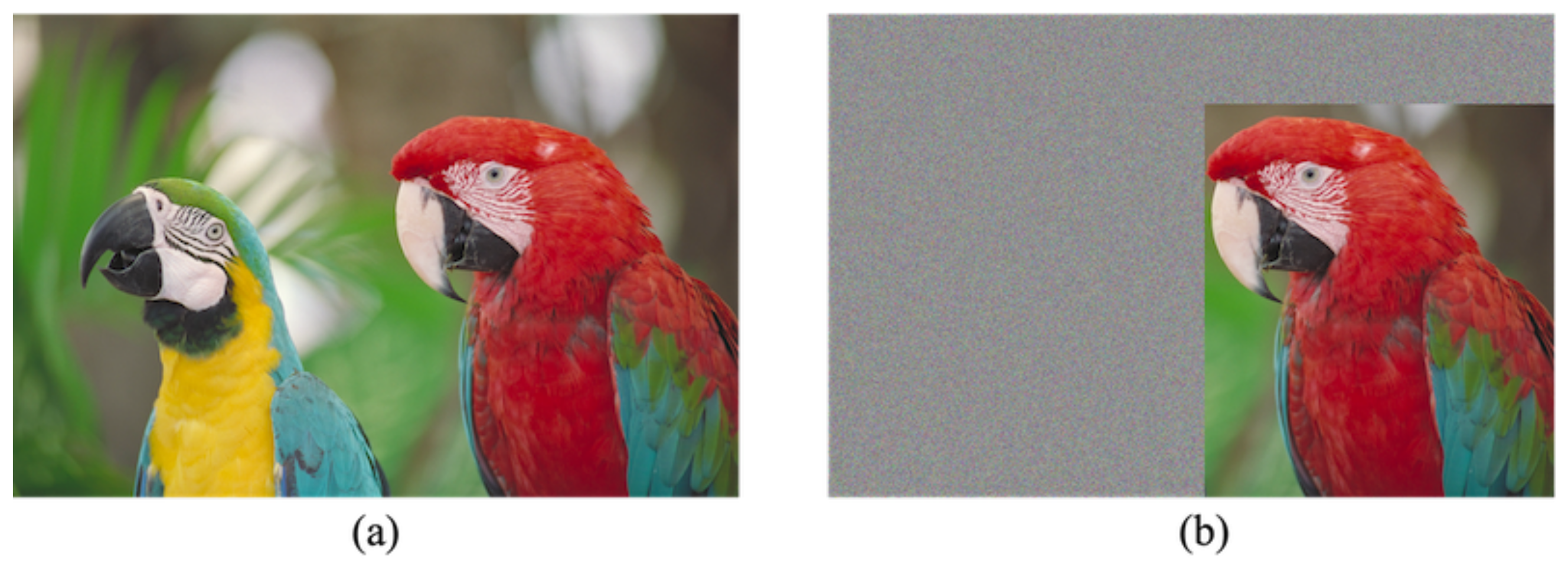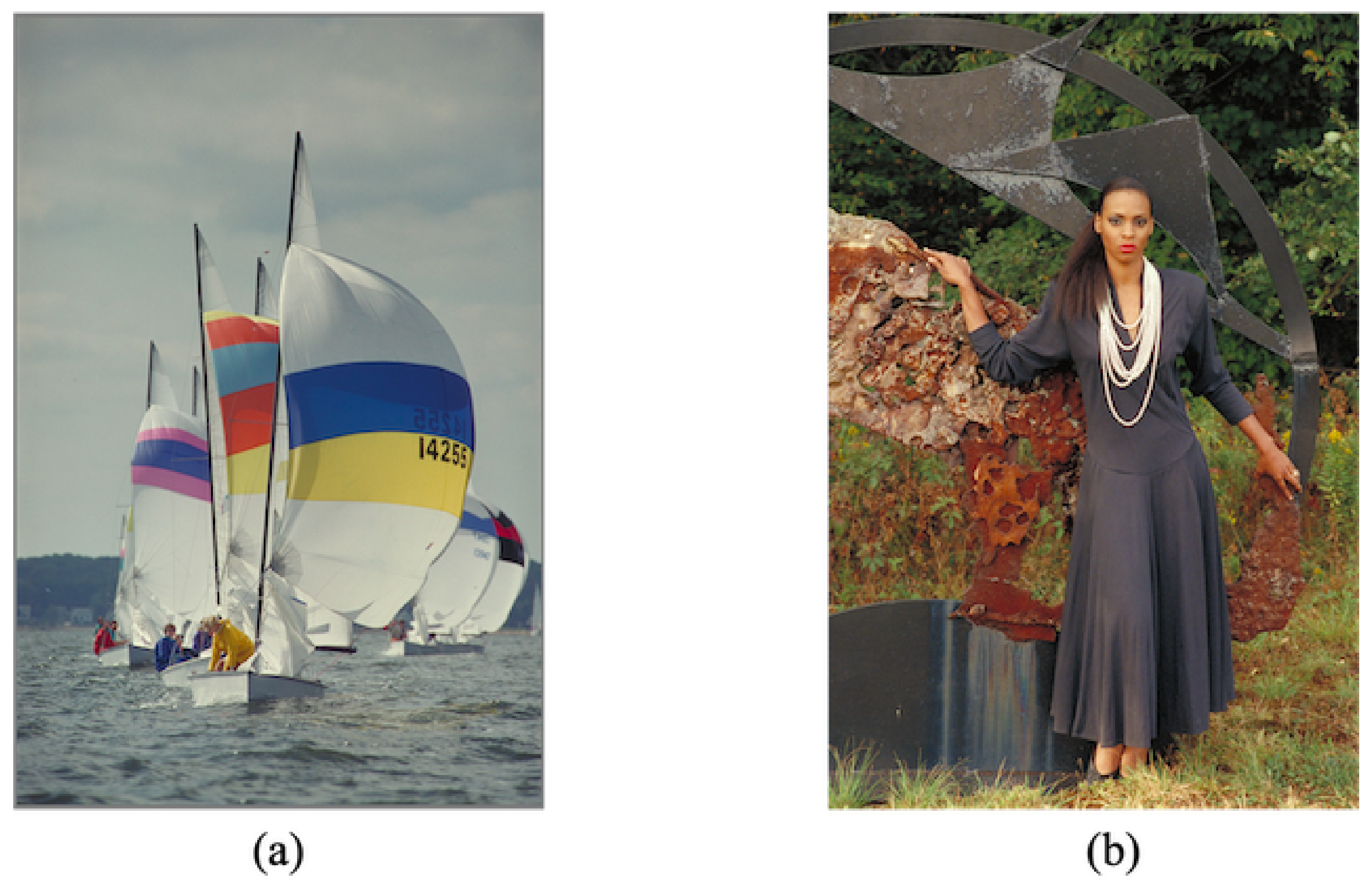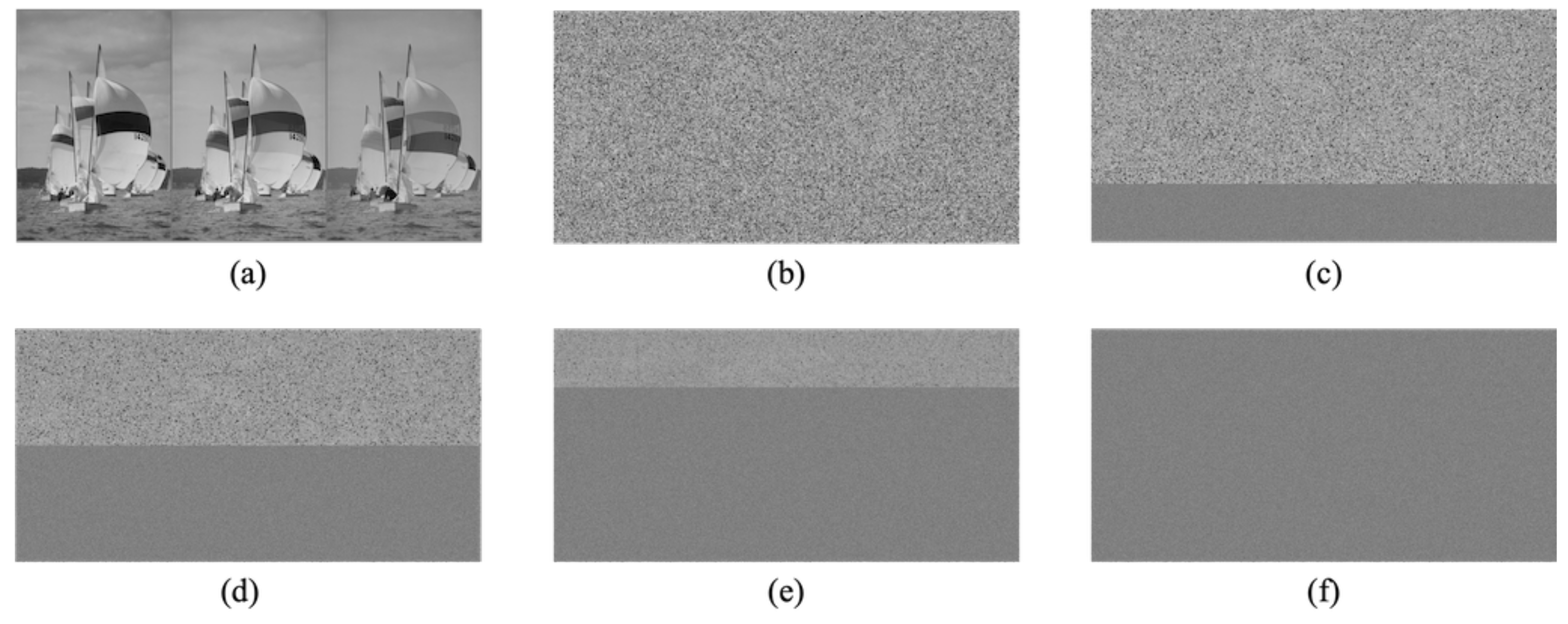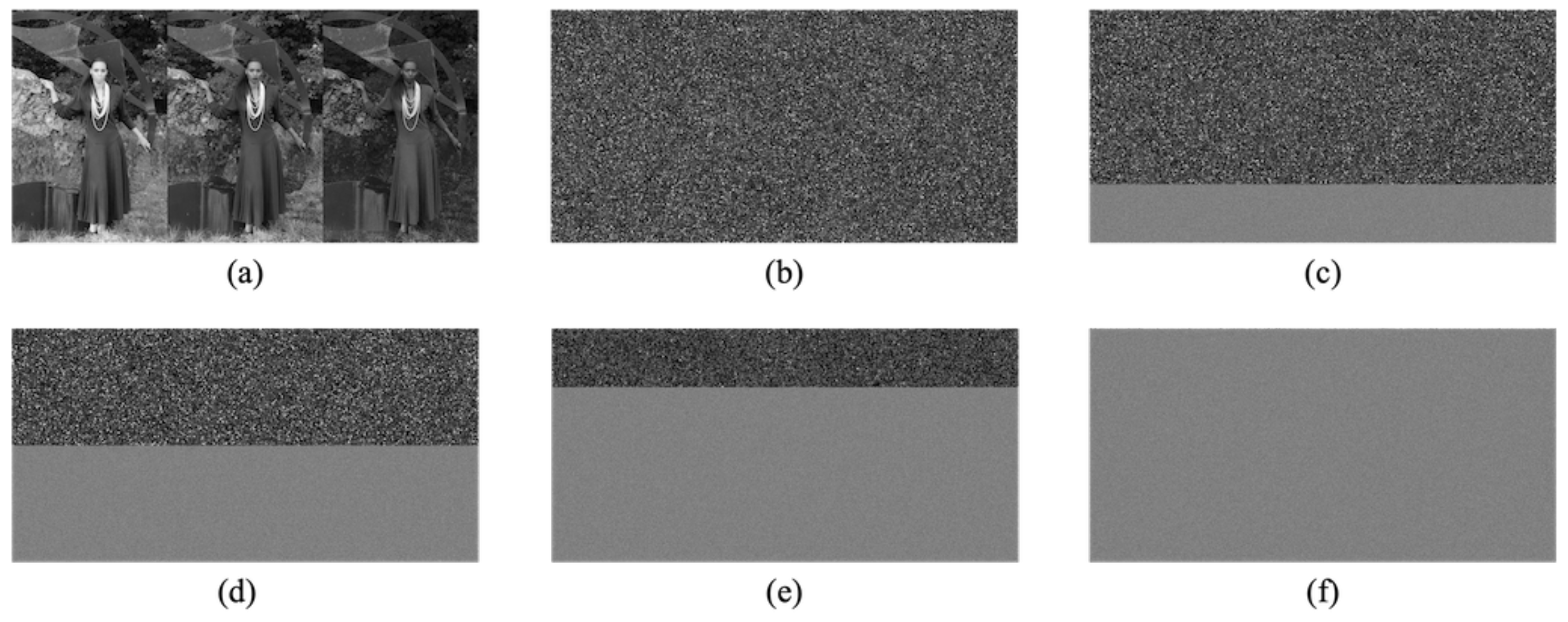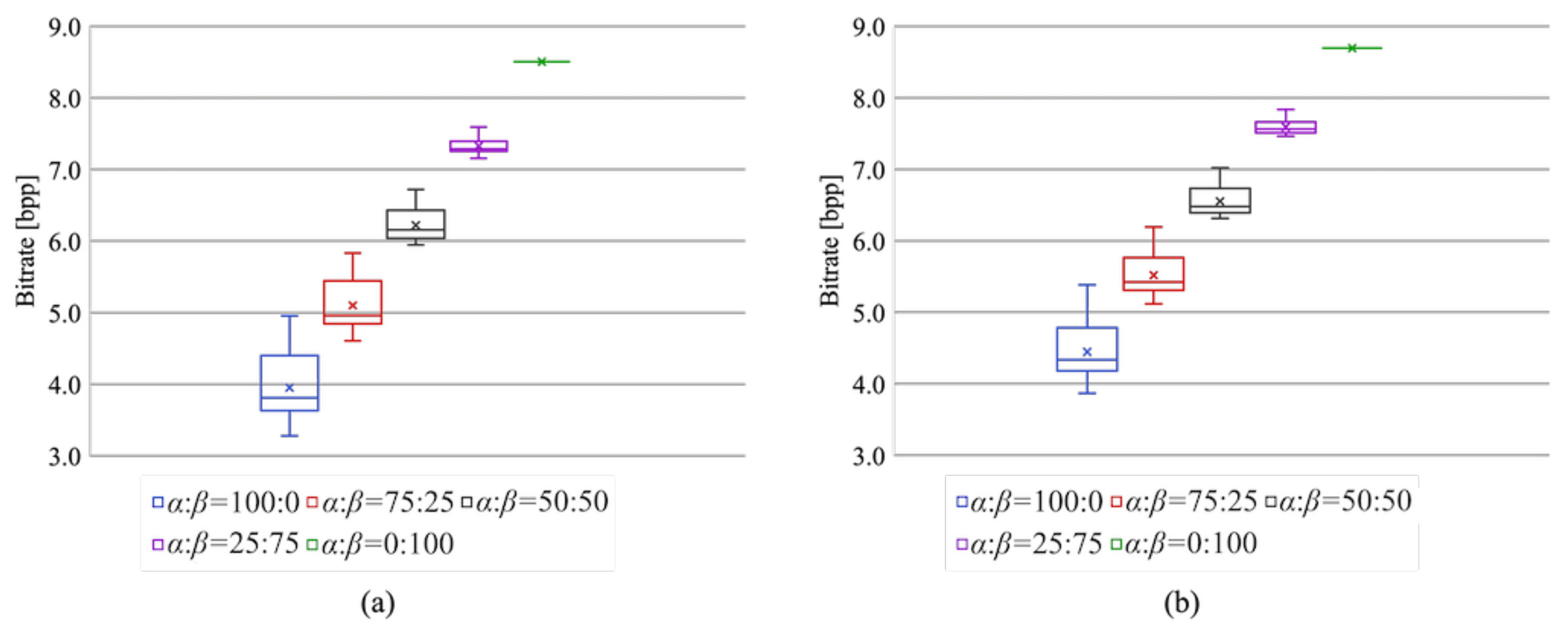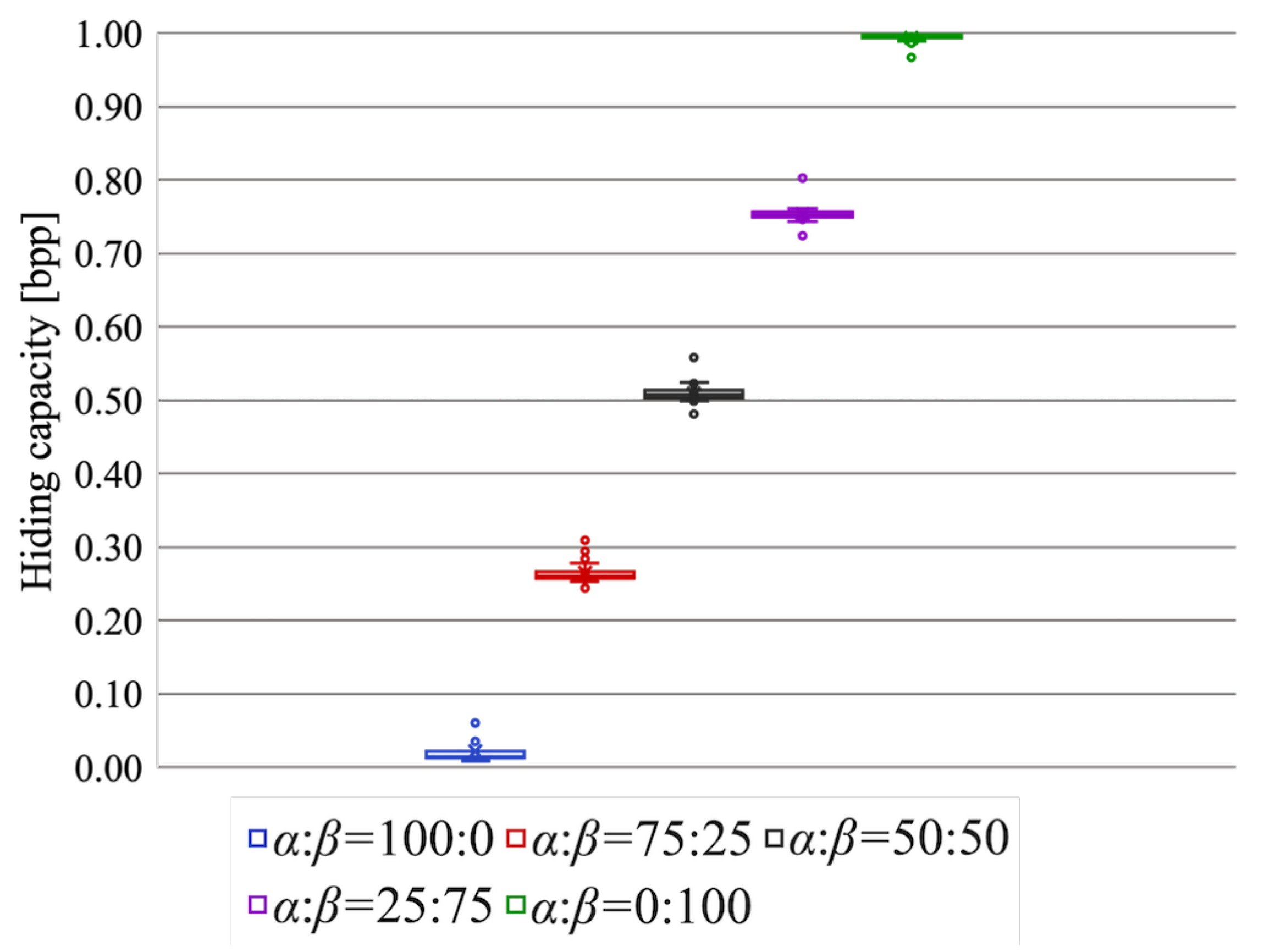1. Introduction
Image data hiding, which is a common security technique for digital images, embeds secret information into a cover image imperceptibly and has attracted attention over recent decades in the image security field. In particular, reversible data hiding (RDH) can perfectly retrieve original images when the embedded payload is correctly extracted [
1,
2,
3,
4,
5,
6,
7,
8,
9]. It is effective not only for natural images but also for medical, military, evidential images, and so forth. Numerous RDH techniques have been proposed for plain images. In recent years, RDH in encrypted images (RDH-EI) has been actively studied [
10,
11,
12,
13,
14,
15,
16,
17,
18,
19,
20,
21,
22]. A high hiding capacity is one of the common requirements in the field of data hiding techniques. If the hiding capacity is large enough, we can embed not only simple copyright information but also a certificate and other important documents. It is difficult to visually recognize encrypted images; in addition to the above common payload, it is required for RDH-EI to allow us to embed information on image content, e.g., categorical data and annotation data, so as to be aware of what kind of images they are without decryption. On another front, an image user may desire to obtain original images or high-quality images that still contain hidden information. RDH-EI methods effectively satisfy such requirements.
An RDH-EI method proposed by Zhang [
10] encrypts a whole image pixel-by-pixel using the exclusive-or operation. Hong et al. [
11] further modified Zhang’s method [
10]. With these methods, however, the payload cannot be perfectly extracted. Another work [
12] has extended Zhang’s method [
10] to improve the marked-image quality. Nevertheless, the payload cannot be correctly extracted if the payload amount becomes large. Ma et al.’s method [
13] provides perfect reversibility. This method first divides an image into two regions in the spatial domain. The least significant bits (LSBs) in one region are embedded into another region, and the entire image is then encrypted by the exclusive-or operation. Thus, the LSBs in the former region are referred to as the embeddable area. A data hider embeds payload bits into the encrypted embeddable area by LSB substitution. With this method, an original image can be restored after only decryption without data extraction. This is because the original LSBs, which would be replaced with payload bits, have been stored in another region. A hiding capacity of up to 0.5 bpp has been attained.
Many RDH-EI methods have been studied to achieve a high hiding capacity [
14,
15,
16,
17,
18,
19,
20]. For example, Puteaux et al. [
14] introduced most significant bit (MSB) prediction and replacement instead of using LSBs. This method does not require any complex processes. Dragoi et al. [
15] enhanced the security of [
14], and Puteaux et al. [
17] further improved the capacity of [
14]. However, there still exist multiple cases where reversibility is not fully ensured. Hirasawa et al. [
18], whose method is referred to as the RDH-MSB method, extended Puteaux et al.’s method [
14] to guarantee full reversibility by defining precise conditions. Wu et al.’s method [
19] attained a higher hiding capacity of 2.2 bpp on average by utilizing Puteaux et al.’s method [
14]. Further, Puteaux et al. [
20] proposed a new RDH-EI method with a higher capacity that guarantees full reversibility and high security. The hiding capacity is 2.4 bpp on average through the recurrent use of MSB prediction. These high-capacity RDH-EI methods, however, cannot decrypt marked encrypted images without data extraction. Additionally, it is difficult for the previous RDH-EI methods to compress their marked encrypted images.
The first method to obtain effective compressibility for marked encrypted images is Imaizumi et al.’s method [
21]. This method uses an encryption-then-compression (EtC) system [
23,
24] and thus can losslessly compress marked encrypted images using image coding standards, such as JPEG-LS [
25] and JPEG 2000 [
26]. Since an image histogram is not transformed before/after the encryption processes, flexible data hiding and extraction in plain and/or encrypted domains are accomplished by using an RDH method based on histogram shift (RDH-HS) [
2]. This method, however, has an extremely low hiding capacity, i.e., about 0.1 bpp. Hereafter, we call this method the RDH-EtC method.
In this paper, we propose a new framework for RDH-EI that can control both the hiding capacity and lossless compression efficiency. Our method tackles the main issue of the RDH-EtC method, namely, the low hiding capacity, without compromising its features. We developed this RDH-EtC framework so that marked encrypted images can be stored with the minimum amount of data while maintaining the required hiding capacity. That could lead to cost savings for storage and data transmission. First, an original image is arbitrarily classified into two regions. The RDH-EtC method is used for one region, and the RDH-MSB method is used for the other region. The former region can be decrypted without data extraction and also compressed by using image coding standards. For the latter region, the hiding capacity is significantly high. Thus, we can choose the embedding region depending on information attributes. Note that there is a trade-off between the hiding capacity and compression efficiency. Through our experiments, we confirm the effectiveness of the proposed method in terms of hiding capacity and lossless compression performance using JPEG-LS and JPEG 2000.
3. Proposed Method
Our proposed framework for RDH-EI controls both the hiding capacity and compression efficiency. First, an original image is arbitrarily classified into two regions: region
and region
. The RDH-EtC method [
21] is used for region
. Here, the proposed method replaces the encryption process in [
21] with Chuman et al.’s method [
27], where the block scrambling-based encryption for EtC systems [
23,
24] is extended to enhance security. Note that the color conversion in [
27] is not performed in our method to ensure full reversibility. In contrast, the RDH-MSB method [
18] is used for region
. Accordingly, region
can be compressed after encryption and also be decrypted without data extraction, while the hiding capacity is low. In contrast, region
has a high hiding capacity of around 1 bpp, while the features in
are compromised.
In the proposed method, any arbitrary high-capacity RDH-EI method can be used instead of the RDH-MSB method. For instance, we could further enhance the hiding capacity by adopting Puteaux et al.’s method [
20], which has a higher hiding capacity of 2.4 bpp on average. We describe the procedure and effectiveness of the proposed method.
3.1. Framework of Proposed Method
The proposed method utilizes the features of the related work and controls both the hiding capacity and lossless compression efficiency. First, it arbitrarily classifies an original image into two regions. In one region, the RDH-MSB method is used to enhance the hiding capacity. In the other region, the RDH-EtC method is used to achieve highly efficient lossless compression. Additionally, the proposed method can decrypt the latter region without data extraction. This means that marked images can be derived with our method. We will precisely compare the proposed method with the related work in
Section 4.2.
We assume that there are two regions in an image referred to as region
and region
. In
Figure 3, for example, the areas marked in red indicate region
.
3.2. Procedure of Proposed Method
Figure 4 illustrates the procedure of the proposed method. We explain each step as follows.
Combine R, G, and B components of an original image I, and a grayscale-based image is obtained.
Classify into region and region , and define them as and , respectively.
Perform the RDH-EtC method [
21] for
, and
is derived.
Perform the RDH-MSB method [
18] for
, and
is derived.
Integrate and into the marked encrypted image .
In Step 1, the order and direction in which to concatenate the color components are arbitrarily defined. Since region
uses the RDH-EtC method, we can first embed a payload and then encrypt the marked
. Therefore, a user can flexibly embed the payload in plain and/or encrypted domains in
. In Step 2, the classification of regions
and
is defined arbitrarily.
Figure 3 is an example of classification, where region
is the areas marked in red. We will describe how the user finds information on the two regions from a marked encrypted image in
Section 4.1.
3.3. Effectiveness of Proposed Method
The proposed method carefully considers the flaws of the previous pieces of work and makes effective use of their advantages. The hiding capacity, which is seriously low in the RDH-EtC method, is enhanced by introducing the RDH-MSB method. The maximum hiding rate of the RDH-EtC method is 0.07 bpp. In contrast, the hiding capacity is approximately 1 bpp in the RDH-MSB method. When the RDH-MSB method is used for 10% of the spatial domain in a target image, the total hiding capacity for the entire encrypted image is improved to around 0.1 bpp without counting the capacity of the other 90%. It is larger than the maximum hiding capacity of the RDH-EtC method only. Therefore, the proposed method can enhance the hiding capacity as the area where the RDH-MSB method is used increases. Further, our method can use an arbitrary high-capacity RDH-EI method instead of the RDH-MSB method. For instance, Puteaux et al. improved the RDH-MSB method and attained a higher hiding capacity of 2.4 bpp on average [
20]. By using this method, we could further enhance the hiding capacity.
In the RDH-MSB method, a marked encrypted image cannot be compressed by image coding standards. Our method improves on this by introducing the RDH-EtC method. The RDH-MSB method uses pixel-based encryption and does not consider the compression performance of marked encrypted images. Conversely, the RDH-EtC method introduces block scrambling-based encryption and thus can losslessly compress marked encrypted images using JPEG-LS [
25] and JPEG 2000 [
26]. In the proposed method, the region processed by the RDH-EtC method can be greatly compressed, while the region processed by the RDH-MSB method cannot be effectively compressed. Overall, marked encrypted images can be compressed to some degree. The compression performance would be enhanced by assigning the RDH-EtC method to a wider region. Note that there is a trade-off between the hiding capacity and compression efficiency.
Figure 5 shows the restoration process with decryption and data extraction of the proposed method. Region
has three restoration options, as shown in
Figure 6. First, our method can retrieve an original image by conducting the normal restoration process, as shown in
Figure 6a. The method has another option for omitting data extraction and only decrypting region
in accordance with
Figure 6b. By using this option, we can obtain a marked image containing a payload. In addition, as shown in
Figure 6c, region
can be decrypted and the payload then extracted. In the first and third options, an original image is reconstructed. Consequently, in region
, we can obtain a marked image containing a payload after decryption. In contrast, the RDH-MSB method requires extracting a payload in the encrypted domain and thus cannot decrypt marked encrypted images without data extraction, as shown in
Figure 7.
Figure 8 shows an example of decryption only in region
, which contains the right-side parrot, with the proposed method. It is clear that the decrypted
has high quality despite still containing the payload. Additionally, we can flexibly embed and extract the payload in
; thus, we suppose three types of models. First, a content owner embeds a payload before encryption. In another case, a third party, such as a channel provider, hides a payload, e.g., server information and time stamps, after encryption. In the third model, by dividing
into further fields, the first and second models can be used for each field, respectively. In any case, the embedded payload can be extracted from either plain or encrypted domains.
Here, we consider the security of the proposed method. Note that we suppose the encryption and data hiding algorithms are disclosed to the public. For the case where an attacker desires to obtain visual information on a target image, the robustness against ciphertext-only attacks (COAs), such as brute force attacks and jigsaw puzzle solver attacks, should be discussed. The robustness against COAs for the RDH-EtC method was fully evaluated in [
21]. On another front, the RDH-MSB method uses an exclusive-or operation, and thus the robustness depends on key management. Consequently, the proposed method is secure under appropriate key management. In contrast, it is also difficult for the attacker to obtain the content of the payload if every payload is encrypted before data hiding.
4. Experimental Results
We confirmed the effectiveness of the proposed method in terms of hiding capacity and lossless compression performance. In the experiments, we used 24 test images from a database of images [
28] with
or
pixels.
Figure 9 shows two examples of the test images. The original images were split into two regions horizontally; the top and bottom regions were defined as region
and region
in our simulation. To confirm the transition in the compression performance and hiding capacity, we used variable area-ratios for
and
, that is, 100:0, 75:25, 50:50, 25:75, and 0:100; we generated five marked encrypted images for each test image. In practice, a user can classify a target image into two regions more flexibly. We concatenated three color components horizontally in the order of R, G, and B. The block size for encryption in the RDH-EtC method was
pixels.
Figure 10 and
Figure 11 show the marked encrypted images obtained by the proposed method.
4.1. Lossless Compression Performance and Hiding Capacity
We evaluated the lossless compression performance using JPEG-LS [
25] and JPEG 2000 [
26].
Figure 12 shows the bitrates of the compressed marked encrypted images. It is clear that the lossless compression performance increased as the area of region
widened. When the area ratio was 0:100, i.e., the RDH-MSB [
18] method was used for the entire image, the bitrates with JPEG-LS and JPEG 2000 compression were higher than 8 bpp. This means that the data amount of the compressed images became higher than that of the original images. In contrast, the proposed method can losslessly compress a marked encrypted image by using the RDH-EtC method [
21] for a portion of an image. Thus, with the proposed method, the compression performance can be controlled according to the area ratio.
The data hiding capacity is shown in
Figure 13. A higher hiding capacity could be attained as the area of region
became wider. When the area ratio was 100:0, that is, the RDH-EtC method was used for the entire image, the hiding capacity was much lower than 0.1 bpp. Conversely, when the RDH-MSB method was performed on the entire image, the hiding capacity was quite high, close to 1 bpp. The proposed method can enhance the capacity up to around 1 bpp with adjusted area ratios for
and
.
In practice, we have to give information on how to classify an image into two regions to the user. As shown in
Figure 3, when region
is chosen with a rectangle shape, the user needs to obtain two coordinates of the top-left and bottom-right pixels of this region. In this simulation, one coordinate is represented by 24 bits, and thus 48 bits are required to locate a single rectangle. If region
contains
n rectangles,
bits would result in the need for region classification. However, this amount is extremely low compared with the entire hiding capacity. In the case of
, 48 bits are approximately 0.001% of the hiding capacity when the RDH-MSB method is applied to the entire image.
In principle, we suppose that region is chosen with a rectangle shape. When multiple rectangles are concatenated, a different shape can be obtained. If a user expects to use other shapes, it is also easy to introduce triangle and circular shapes. In the case of a circular shape, we store a coordinate of the center pixel and a radius of the circle. When region consists of rectangle shapes, the data format can be represented as (Number of rectangles = || (, ), (, ), ..., (), ()).
Figure 14a shows the lossless compression performance using JPEG-LS for three test images, while
Figure 14b shows the data hiding capacity for those three images. As shown in
Figure 14, the trade-off between the lossless compression performance and hiding capacity shows a linear variation for each image, although each image had a different value and slope in general. As for the lossless compression, the best performance could be obtained when the RDH-EtC method was used for the entire image. In contrast, the highest hiding capacity could be attained when the RDH-MSB method was used for the entire image. The proposed method, however, enables us to combine the RDH-EtC and RDH-MSB methods and thus does not simultaneously accomplish both the highest compression efficiency and hiding capacity. Nevertheless, images can be stored with the minimum amount of data under the required hiding capacity by using the proposed method. The proposed framework could be used in a wider range of fields, including cloud and social networking services.
4.2. Comparisons between Proposed Method and Related Work
We show a comparison of the proposed method with the related work in
Table 1. The RDH-EtC method can compress marked encrypted images using lossless image coding standards. Further, it can decrypt marked encrypted images without data extraction and thus can derive marked images from them. In addition, it is possible for us to first decrypt marked encrypted images and then extract the payload. The other methods do not have such advantages as the RDH-EtC method. Instead, they have a high hiding capacity, while the RDH-EtC method has a significantly low one. The proposed method utilizes the advantages of both the RDH-EtC and RDH-MSB methods, and it can control the hiding capacity and compression efficiency. Note that since there exists a trade-off between the compression performance and hiding capacity, the proposed method does not simultaneously accomplish both the highest compression efficiency and hiding capacity.
5. Conclusions
We proposed a new framework for RDH-EI in this paper. Our method has two main advantages compared with the related work. First, we can store marked encrypted images with the minimum amount of data under the required hiding capacity. An original image is arbitrarily classified into two regions; one region can be highly compressed even after encryption and data hiding, while the other region attains a high hiding capacity. Our method controls the trade-off between the lossless compression efficiency and hiding capacity depending on the user’s request. In addition to the flexible control of the trade-off, we can freely extract the embedded payload before/after decryption in one region. Namely, the decryption process does not require data extraction. Experimental results show that the compression performance and hiding capacity were flexibly controlled depending on the area ratio between two regions. The proposed method, however, is a combination of two RDH-EI methods and thus does not simultaneously accomplish both the highest compression efficiency and hiding capacity.
A constraint on data extraction still remains in the other region, where data extraction must be conducted before decryption. In our future work, we will alleviate this constraint to extend the range of application.
